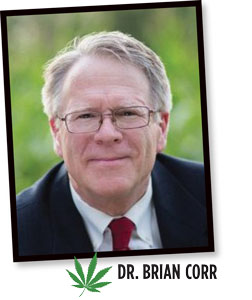9/1/2019
Blowin’ in the Wind …?
Dr. Brian Corr

People with diverse opinions about cannabis consider the provision in the 2018 United States Farm Bill allowing for production of hemp a good thing. For the purpose of the Farm Bill, hemp is defined as cannabis with less than 0.3% tetrahydrocannabinol (THC), the compound in marijuana that produces a high. The THC limit distinguishes cannabis grown as “hemp” from cannabis grown as “marijuana.”
Since no one is going to get high from cannabis with so little THC, opponents of marijuana can be comfortable, while farmers are allowed (relatively) unfettered production of hemp for fiber, seed and extraction of compounds from the plant other than THC.
Although fiber and seed are important products from hemp, what’s getting the most attention is extraction of cannabinoids other than THC, notably cannabidiol (CBD), the non-psychoactive cousin of THC.
CBD is being added to cosmetics, health products, vape pens and even pet products. A recent poll shows 25% of Americans have tried CBD, with that number rising to 40% when only the 18 to 29 demographic is considered.
So, with the passage of the Farm Bill, U.S. farmers can now begin to grow a crop that’s been profitable for farmers around the world. Farmers who’ve grown hemp under experimental programs have reported profitability far greater than most crops.
That’s all good, right?
Well, there are some complications. Producers of hemp for CBD and producers of marijuana for recreational or medicinal purposes all wish to produce flower buds devoid of seed. The word “sinsemilla,” which became synonymous with quality marijuana, is a combination of two Spanish words that mean “without seed.”
Marijuana growers are able to produce flowers buds without seeds because an individual cannabis plant typically has only male or female flowers. Only male flowers produce pollen. By growing only female plants, marijuana growers ensure no pollen reaches the developing flowers. No pollen, no seeds.
Growers of hemp for CBD extraction and growers of marijuana have the same goal—all female plants and no pollen. However, farmers producing hemp for seed have a completely opposite goal—they need pollen or they don’t get seed. Farmers growing hemp for fiber are less concerned one way or the other, but don’t mind the pollen.
However, hemp and marijuana are the same genus and species. Pollen from hemp plants can pollinate flowers on marijuana plants, as well as hemp grown for CBD, resulting in low-quality flower buds “con semilla’’ (with seeds).
Unlike roses and similar flowers that require bees or other pollinators to move pollen from flower to flower, cannabis has a strategy for pollination that emphasizes wind pollination. Cannabis pollen is lightweight and blows freely in the wind over long distances from one cannabis plant to another.
As fields of hemp become more common (perhaps 200,000 acres in the U.S. in 2019), the issue of cannabis pollen blowing to areas where it’s unwanted is starting to get attention. Marijuana growers are especially worried. After investing millions of dollars in their production facilities, will their product be damaged by pollen drifting in?
With more and more field production of hemp, the goal of never having a single grain of pollen reaching the crop is nearly impossible without significant investment in filtration. Cannabis pollen is about 25 microns in diameter. It can be largely filtered out in warehouse growing situations, but filters are impractical for greenhouses and certainly not an option in the field.
Does that mean greenhouse and field growers are out of luck? Not necessarily. The amount of pollen in the air declines dramatically as the distance from the source increases. Canadian certified hemp seed producers are required to be at least 5 kilometers (3.1 miles) away from another pollen source. That distance doesn’t guarantee zero pollen will reach the plants—one study showed cannabis pollen can blow across the Mediterranean Sea from Africa to Europe. However, the certifying agency has concluded the risk is acceptable at 5 kilometers.
So locating production of seedless cannabis far from a pollen source is helpful, but distance cannot guarantee there will be absolutely no pollen.
All is not lost. What matters isn’t how much pollen is in the air, but how much viable pollen is in the air. If the pollen dies before it reaches female plants, there’ll be no seed. At high humidity, cannabis pollen dies quickly. Much of the U.S. has high humidity when field hemp is producing pollen, which will minimize how long pollen survives.
For growers producing year-round in greenhouses or warehouses, there’s additional good news: pollen is only produced in the field for a portion of the summer. Since different varieties flower at different times, and there will be different planting times, I expect pollen will be in the
air for six weeks or so, but the rest of the year the risk drops off.
Unfortunately, it’s inevitable CBD hemp, and recreational and medicinal marijuana will receive some undesired pollen from hemp fields. However, I believe it won’t be as bad as some people are making it out to be—unless there’s a hemp field right next door, the number of seeds will be at nuisance levels, not catastrophic. GT
Dr. Brian Corr is a consultant with more than four decades of experience in the greenhouse industry. He has advised legal cannabis producers for the last three years. You can reach him at Brian.Corr@SycamoreHortConsulting.com.